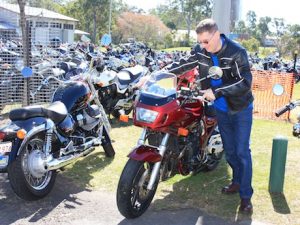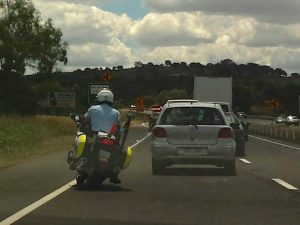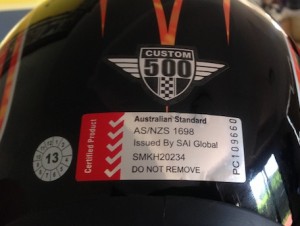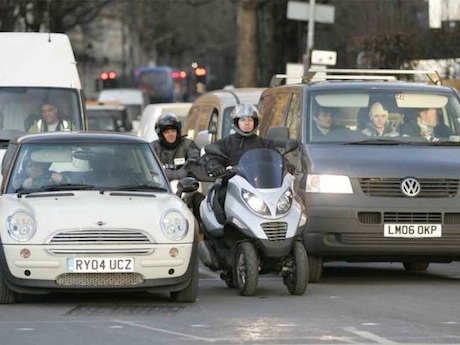Motorcycle lane filtering, common sense rules on having your hands and feet on the bars and footpegs, and international helmet standards could soon be adopted in Queensland.
The proposals are being put forward in a discussion paper by Queensland Transport Minister Scott Emerson tomorrow. It comes after recent changes in NSW lane-filtering laws. It also follows the recent controversy of a rider being fined $146 for taking his foot off the pegs to stretch his leg while a police officer filmed doing the same thing was not fined and even the police commissioner admitted he stretched his legs while riding. As for the helmet laws, they are an ongoing issue of interstate disagreement causing confusion among riders as they cross the state boundaries. All of these issues have been discussed before on MotorbikeWriter.com. Check out some of the articles below under the heading “Stories You May Also Like”.
The public is invited to give their opinion on the suggested changes with an online survey. You will need to register first and get a password. To ensure riders get a fair go, I suggest every motorcycle and scooter rider click on the link and have their say. The great news is you don’t have to be a Queenslander, because it only requires an email address. In fact, you don’t even have to be Australian!
For a government that so hastily brought in the VLAD Act last year, the suggested law changes are quite common sense and well-considered.
Interestingly, they don’t blindly follow the lead of NSW’s lane-filtering laws. Instead they suggest riders can still share lanes and can use kerbside breakdown lanes which is a much more sensible approach. However, there are other restrictions such as a ban on learners and new riders from lane-filtering and exclusion zones such as around schools.
The Minister points out that lane filtering will benefit all motorists, not just favour motorcyclists. “It could ease traffic congestion and make the rules clearer for all road users,” he says.

RACQ technical officer and a keen motorcyclist, Steve Spalding says they don’t oppose motorcyclists lane filtering but believe it is important to do so “in a safe and courteous manner and that the motorcyclist is filtering slowly through stationary traffic”. The discussion paper suggestion is up to 30km/h.
“There are some situations, such as when large vehicles are queuing, that it is safer for the motorcyclist to wait rather than try and squeeze between vehicles and put their safety at risk,” he says. Sounds like riders should exercise some commonsense!
“We also recognise that not all motorcyclists are comfortable with the practice of lane filtering and that it is an individual’s choice as to whether they choose to do it or not,” Steve says. “Most experienced motorcyclists are very much aware of their safety exposure in heavy traffic situations and ride accordingly.

On the issue of using your hands and feet for control of the bike, it suggests simply dispensing with the current complex and arcane set of rules and to simply “retain broader rules in relation to motorcycle riders maintain proper control”, riding with due care and attention and not operating the bike dangerously.
“While the intention of the rule was to prevent reckless and dangerous behaviour, it doesn’t take into account the everday practicalities of riding a motorcycle,” the Minister says. “By broadening the rules, it will mean a rider can remove their feet to reverse park, or take their hands off the handle to adjust their visor and not be in breach of the law.”
The RACQ also supports changes that “provide a more practical approach compared to the present requirements”.

As for helmets, the authorities have thrown up their hands and said it’s all a bit complex and shouldn’t they just let the best international standards apply! The paper even recognises the popularity of buying helmets online because they are cheaper from overseas.
All these suggestions make a lot of sense, but we may also end up with more conflicting rules across state boundaries. It would make much more sense to have a broader national view, but at least the state is starting to make some sense and pay attention to the growing number of motorcycle riders in the state, up 18% in the past five years to 186,120 registered riders.
Following is the full text of the discussion paper:
Motorcycle discussion paper
Road rules for motorcycle riders
Introduction
Motorcycle riding has increased in popularity in Queensland in recent years. More people are using motorcycles for commuting and recreational purposes for a variety of reasons: for example they are cheaper to run than a car; they take less parking space; and they may help the rider avoid traffic congestion.
The below table shows the steady increase in registered motorcycles in Queensland over the past five years.
| Year | Number of registered motorcycles |
| 2009 | 157,583 |
| 2010 | 161,266 |
| 2011 | 168,552 |
| 2012 | 177,478 |
| 2013 | 186,120 |
In May 2014, the Minister for Transport and Main Roads approved the public release of a discussion paper to obtain feedback from all Queenslanders on reducing red tape and improving transport outcomes for motorcycle riders whilst preserving safety outcomes.
Purpose of this discussion paper
The purpose of this discussion paper is to seek feedback from Queenslanders on some possible changes to existing policies for motorcycle riders that could be introduced to reduce red tape and regulation and to create a more efficient road network.
The proposed changes in this paper have been identified through reviewing the current policies, and considering existing Queensland crash and offence data, relevant research, and also what is happening elsewhere in Australia and overseas.
It should be noted that these proposals are not government policy and are for consultation purposes only. The government is seeking the views of Queenslanders before considering the possible implementation, costs and likely benefits of any new initiatives.
Method
Community feedback on this discussion paper will be obtained by an online survey on the Queensland Government’s Get Involved website (see www.getinvolved.qld.gov.au). The survey will take 5 to 10 minutes, depending on how much feedback respondents wish to provide, and will be open for community feedback for six weeks.
Queenslanders are invited to review the discussion paper and complete the online survey to show whether they support or do not support each of the proposals. They are also able to provide extra comments or skip questions they do not wish to answer. No demographic information will be collected from the people who complete the survey.
Initiatives being considered
This discussion paper considers three initiatives:
- Lane filtering
- Motorcycle control
- Motorcycle helmets
- Lane Filtering
Riding a motorcycle through traffic or overtaking between vehicles on a multilane road at high speed is dangerous, but are the same dangers present at low speeds?
The terms ‘lane filtering’ and ‘lane splitting’ can have different meanings. In this paper, lane filtering is used to describe a motorcycle rider moving at low speed through stationary or slow moving vehicles and lane splitting is used to describe a motorcycle rider moving at higher and potentially unsafe speed through moving traffic.
The current Queensland rules do not specifically ban lane filtering or lane splitting. But there are several road rules that motorcycle riders may break if they are lane filtering or lane splitting. This makes it hard for motorcycle riders to legally lane filter or lane split. Rules that motorcycle riders are likely to break include:
- not staying within a marked lane
- changing lanes without signalling, or without signalling for sufficient time
- not leaving a safe distance when overtaking another vehicle
- changing lanes across continuous lines
- crossing a white edge line or riding in a special purpose lane
- not stopping at a stop line at traffic lights
- overtaking to the left of a vehicle
Should there be change?
Lane filtering is often already practised by motorcycle riders on Queensland roads, especially when traffic is congested, despite the potential for breaking the road rules. If done safely, lane filtering may ease traffic congestion for all road users.
But there are some potential dangers associated with lane filtering. Pedestrians may face a greater safety risk from both a lack of awareness of motorcycle riders being allowed to lane filter and from motorcycle riders moving unpredictably in areas which pedestrians frequent. The motorcycle rider also may face a greater danger when lane filtering from vehicles suddenly changing lanes or drivers opening vehicle doors without looking. However, these dangers can be minimised by applying appropriate conditions for when and where lane filtering can be undertaken.
Allowing lane filtering in Queensland would mean that our road rules may be different from those elsewhere in Australia, so motorcycle riders would have to be aware of this when riding interstate.
What evidence is there?
There is limited research on the risks and benefits of lane filtering by motorcycle riders. Findings about the percentage of motorcycle crashes directly caused by lane filtering vary, however some studies have shown that lane filtering was a factor in less than one to five percent of motorcycle crashes. A study from the United States compared crash statistics in California, where lane filtering is legal, with those of other states and concluded that lane filtering reduces the risk of rear-end crashes for motorcycle riders. However, research from the United Kingdom found that crashes sometimes occurred when drivers did not check for lane filtering motorcycle riders in traffic.
New South Wales conducted a trial of lane filtering in parts of Sydney in 2013, which indicated that the risks for motorcycle riders are low provided certain safety conditions are met, and that motorcycle travel times may be reduced and congestion benefits may increase as the number of motorcycle riders increases.
What’s happening elsewhere?
Other Australian states and territories currently have similar rules to Queensland which essentially discourage lane filtering and lane splitting.
However, following their trial, New South Wales is introducing changes to its laws to allow lane filtering. Under these laws, lane filtering will refer to a motorcycle rider riding at a speed of 30km/h or less between lanes of stopped or slow moving vehicles. Lane splitting (that is, riding at a speed over 30km/h between lanes of traffic) will be illegal, and a new rule specifically banning lane splitting is being introduced. It is anticipated the new laws will commence 1 July 2014.
Lane filtering is legal in California in the United States, the United Kingdom and some other European countries.
Possible changes
While taking the New South Wales lane filtering proposed laws into consideration, Queensland does not have to mirror them. For example, the proposed New South Wales maximum lane filtering speed of 30km/h may not be considered the correct speed for Queensland conditions.
Further, under its new laws, New South Wales is proposing to prevent motorcycle riders from lane filtering in kerb side lanes or next to parked vehicles, areas where they can currently legally ride. In Queensland and in most other jurisdictions, motorcycle riders in the act of passing can legally ride alongside another vehicle in a lane or share a lane with a parked vehicle, provided there is sufficient space to pass safely.
If lane filtering is introduced, Queensland is considering allowing these practices to continue and possibly changing some other road rules. This approach may allow motorcycle riders to ride on parts of the road where they cannot currently ride, such as sealed areas to the left of the edge line and bicycle storage areas. A bicycle storage area is the area of road close to an intersection with traffic lights that allows cyclists to wait in front of vehicles stopped at the intersection; they are usually painted green with white bicycle symbols (refer to diagram below).
It is proposed to allow lane filtering in Queensland with suitable conditions attached to help ensure the safety of all road users. It is proposed motorcycle riders will only be allowed to ride between stationary or slow moving vehicles under the following conditions:
- it is only allowed ‘when safe to do so’
- riders must not filter at high speeds (for example speeds in excess of 30km/h)
- learner and provisional riders are not permitted to lane filter because of their inexperience
- lane filtering is not allowed in school zones during school zone hours
- motorcycle riders will also be warned for their own safety not to lane filter near heavy vehicles or buses
It is also proposed to create a new offence for lane splitting. This offence would apply to motorcycle riders lane splitting at high speeds (for example speeds in excess of 30km/h), and would be in addition to the other penalties that may currently apply.
Have your say via the online survey.
Visit the Queensland Government’s Get Involved website (www.getinvolved.qld.gov.au) to have your say.
- Motorcycle Control
Maintaining proper control of the motorcycle is critical for safe riding but prescriptive requirements need to be balanced with the practical realities of riding a motorcycle
Maintaining proper control of the motorcycle is critical for safe riding. The current rules say that the rider of a motorcycle that is moving must keep both feet on the motorcycle’s footrests; if the motorcycle is moving or stationary (but not parked), the rider must sit astride the rider’s seat facing forwards with at least one hand on the handlebars. In addition, there are other rules that say motorcycle riders must have proper control of their motorcycle, must ride with due care and attention, and must not operate their motorcycle dangerously.
Should there be change?
The rules specifying where motorcycle riders must have their hands and feet, and how they must sit on the motorcycle were intended to give riders clear guidelines to make sure they have proper control of their motorcycle. They were also intended to prevent unsafe, reckless or dangerous behaviour, such as stunt riding.
But these rules do not adequately take into account the everyday practicalities of riding a motorcycle. Riders break the rule about keeping both feet on the footrests if they remove their feet to reverse into a parking space, decelerate to stop, or accelerate after stopping. Similarly a rider breaks the current rules if they use both hands to adjust a visor while the motorcycle is stationary.
These specific rules were originally put in place to ensure safe riding but other broader rules about having proper control of a motorcycle, riding with due care and attention, and not operating a motorcycle dangerously already make unsafe riding illegal. This means that the more specific rules may be redundant and could be removed without compromising safety.
Changing the Queensland road rules about motorcycle control would mean our road rules may be different from those elsewhere in Australia, so motorcycle riders need to be aware of this when riding interstate.
What evidence is there?
There is limited evidence regarding the effectiveness of these specific rules. Very few traffic infringement notices, fewer than 30 per year on average, are issued to motorcycle riders in Queensland for not having their hands, feet or body in the correct position on the motorcycle.
What’s happening elsewhere?
All Australian states and territories have similar rules that the rider must sit astride the rider’s seat facing forwards, keep both feet on the footrests and ride with at least one hand on the handlebars. But all other jurisdictions are considering relaxing these rules to say that a motorcycle rider:
- may take their feet off the footrests, if the motorcycle is moving at less than 10km/h and the rider is parking the motorcycle, decelerating to stop or accelerating after stopping; and
- must only keep at least one hand on the handlebars if the motorcycle is moving; they may remove both hands if the motorcycle is stationary.
Possible changes
It is proposed to remove the rules about where motorcycle riders must have their hands and feet, and how they must sit. It is intended to retain broader rules in relation to motorcycle riders maintaining proper control of their motorcycle, riding with due care and attention, and not operating their motorcycle dangerously.
Information about safe operation of motorcycles is available in the Queensland Motorcycle Riders’ Guide.
Have your say via the online survey.
Visit the Queensland Government’s Get Involved website (www.getinvolved.qld.gov.au) to have your say.
- Motorcycle Helmets
Motorcycle helmets provide protection in the event that the rider is involved in a crash
Motorcycle helmets are designed and manufactured to meet a range of performance requirements including resistance to penetration, impact absorption, strength of the retention system (usually a strap to the lower jaw area) and peripheral vision.
It is law that motorcycle riders and their passengers must wear an approved motorcycle helmet securely fitted and fastened on their head. In Queensland an approved helmet is one that complies with Australian standards AS1698 or AS/NZS1698, or another standard that is considered at least equal to these standards. Because it is so difficult to compare different standards with their differing performance requirements, no overseas motorcycle helmet standards have as yet been approved. This means only motorcycle helmets that comply with the Australian standards can be legally worn in Queensland.
Should there be change?
The large number of motorcycle riders in other countries (for example, Japan has approximately six times and Western Europe four times more motorcycle riders than Australia), means that the range of helmets manufactured is greater. Helmets approved under overseas standards such as the European, United States or Japanese standards offer a much larger range.
Only approving helmets that meet the Australian standard limits the range of helmets available for use, and in some instances the sizing allowed by the Australian standard does not cater for larger head sizes.
As the international and national markets for helmets grow with increasing motorcycle use and as ‘on-line’ retail increases, it is timely to review approved helmet standards in Queensland.
It is very important that motorcycle rider and passenger safety is not compromised by the acceptance of standards that are not at least equivalent to the Australian standard.
Changing the Queensland rules about motorcycle helmets would mean that rules may be different from those elsewhere in Australia, so motorcycle riders would have to be aware of this when riding interstate.
What evidence is there?
A range of studies over the past few decades discussing helmet use clearly show that wearing a motorcycle helmet reduces fatality and head injury rates compared to not wearing a helmet. The non-use of helmets has been identified as a specific factor leading to head injuries and fatalities resulting from motorcycle crashes. Helmets as a protective measure have been identified to be effective towards head injury prevention and reducing the fatality risk of motorcycle riders by 34 percent.
However, there is still debate when comparing helmet standards and how these influence helmet performance. Generally speaking, standards applied in Europe, the United States and Japan are similar to Australian standards. However, key differences include how tests are carried out, what is tested and variations in acceptable results (for example rigidity).
What’s happening elsewhere?
All Australian states and territories require motorcycle riders and passengers to wear approved helmets, and most jurisdictions only approve helmets that meet Australian standards.
New South Wales has a medical exemption for a rider whose head is too large to fit safely and comfortably into an approved Australian helmet, allowing them to wear a helmet complying with specified European, American and Japanese standards.
Possible changes
It is proposed to investigate the adoption of other motorcycle helmet standards within Queensland. In considering the possible recognition of other standards the quality and integrity of the helmet must be maintained, given their important safety function.
Have your say via the online survey.
Visit the Queensland Government’s Get Involved website (www.getinvolved.qld.gov.au) to have your say.
References
Lane filtering:
New South Wales. Centre for Road Safety. Lane filtering. Accessed April 2014 at http://roadsafety.transport.nsw.gov.au/stayingsafe/motorcyclists/lanefiltering/index.html
Crundall, D., Clarke, D., Ward, P. & Bartle, C. (2008). Car Drivers’ Skills and Attitudes to Motorcycle Safety: A Review. Road Safety Report No. 85. London, UK: Department for Transport. Accessed April 2014 at http://webarchive.nationalarchives.gov.uk/20090417002224/http://www.dft.gov.uk/pgr/roadsafety/research/rsrr/theme2/rsrr85.pdf
Guderian,S. (2012). Lane sharing as a motorcycle rider safety practice; a further evaluation. Accessed April 2014 at http://www.smarter-usa.org/documents/lane-sharing-2012.10-motorcycle-consumer-news.pdf
Sperley, M. & Pietz, A. (2010). Motorcycle Lane Sharing: Literature Review. Report No. OR-RD-10-20. Oregon, USA: Oregon Department of Transportation.
Motorcycle control:
Queensland. Department of Transport and Main Roads. (2013). Queensland Motorcycle Riders’ Guide. Accessed April 2014 at http://www.tmr.qld.gov.au/Safety/Motorcycle-safety/Queensland-Motorcycle-Riders-Guide.aspx
Motorcycle helmets:
World Health Organization (2006). Helmets: A Road Safety Manual for Decision-makers and Practitioners. WHO, Geneva, Switzerland. Accessed April 2014 at http://www.who.int/violence_injury_prevention/publications/road_traffic/helmet_manual.pdf
Keng, S. (2005). Helmet use and motorcycle fatalities in Taiwan. Accident Analysis and Prevention, 31, 349-55. Abstract accessed April 2014 at http://www.ncbi.nlm.nih.gov/pubmed/15667822
Dee, T. (2009). Motorcycle helmets and traffic safety. Journal of Health Economics, (2): 398-412. Abstract accessed April 2014 at http://www.ncbi.nlm.nih.gov/pubmed/19157608


